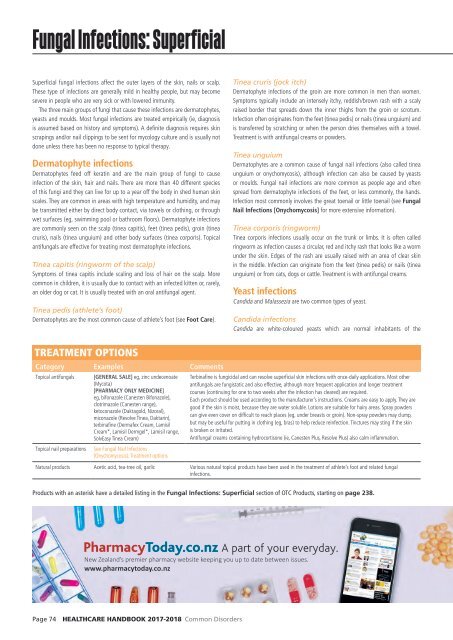2017 HCHB_digital
Create successful ePaper yourself
Turn your PDF publications into a flip-book with our unique Google optimized e-Paper software.
Fungal Infections: Superficial<br />
Superficial fungal infections affect the outer layers of the skin, nails or scalp.<br />
These type of infections are generally mild in healthy people, but may become<br />
severe in people who are very sick or with lowered immunity.<br />
The three main groups of fungi that cause these infections are dermatophytes,<br />
yeasts and moulds. Most fungal infections are treated empirically (ie, diagnosis<br />
is assumed based on history and symptoms). A definite diagnosis requires skin<br />
scrapings and/or nail clippings to be sent for mycology culture and is usually not<br />
done unless there has been no response to typical therapy.<br />
Dermatophyte infections<br />
Dermatophytes feed off keratin and are the main group of fungi to cause<br />
infection of the skin, hair and nails. There are more than 40 different species<br />
of this fungi and they can live for up to a year off the body in shed human skin<br />
scales. They are common in areas with high temperature and humidity, and may<br />
be transmitted either by direct body contact, via towels or clothing, or through<br />
wet surfaces (eg, swimming pool or bathroom floors). Dermatophyte infections<br />
are commonly seen on the scalp (tinea capitis), feet (tinea pedis), groin (tinea<br />
cruris), nails (tinea unguium) and other body surfaces (tinea corporis). Topical<br />
antifungals are effective for treating most dermatophyte infections.<br />
Tinea capitis (ringworm of the scalp)<br />
Symptoms of tinea capitis include scaling and loss of hair on the scalp. More<br />
common in children, it is usually due to contact with an infected kitten or, rarely,<br />
an older dog or cat. It is usually treated with an oral antifungal agent.<br />
Tinea pedis (athlete’s foot)<br />
Dermatophytes are the most common cause of athlete’s foot (see Foot Care).<br />
Tinea cruris (jock itch)<br />
Dermatophyte infections of the groin are more common in men than women.<br />
Symptoms typically include an intensely itchy, reddish/brown rash with a scaly<br />
raised border that spreads down the inner thighs from the groin or scrotum.<br />
Infection often originates from the feet (tinea pedis) or nails (tinea unguium) and<br />
is transferred by scratching or when the person dries themselves with a towel.<br />
Treatment is with antifungal creams or powders.<br />
Tinea unguium<br />
Dermatophytes are a common cause of fungal nail infections (also called tinea<br />
unguium or onychomycosis), although infection can also be caused by yeasts<br />
or moulds. Fungal nail infections are more common as people age and often<br />
spread from dermatophyte infections of the feet, or less commonly, the hands.<br />
Infection most commonly involves the great toenail or little toenail (see Fungal<br />
Nail Infections [Onychomycosis] for more extensive information).<br />
Tinea corporis (ringworm)<br />
Tinea corporis infections usually occur on the trunk or limbs. It is often called<br />
ringworm as infection causes a circular, red and itchy rash that looks like a worm<br />
under the skin. Edges of the rash are usually raised with an area of clear skin<br />
in the middle. Infection can originate from the feet (tinea pedis) or nails (tinea<br />
unguium) or from cats, dogs or cattle. Treatment is with antifungal creams.<br />
Yeast infections<br />
Candida and Malassezia are two common types of yeast.<br />
Candida infections<br />
Candida are white-coloured yeasts which are normal inhabitants of the<br />
TREATMENT OPTIONS<br />
Category Examples Comments<br />
Topical antifungals<br />
Topical nail preparations<br />
[GENERAL SALE] eg, zinc undecenoate<br />
(Mycota)<br />
[PHARMACY ONLY MEDICINE]<br />
eg, bifonazole (Canesten Bifonazole),<br />
clotrimazole (Canesten range),<br />
ketoconazole (Daktagold, Nizoral),<br />
miconazole (Resolve Tinea, Daktarin),<br />
terbinafine (Dermafex Cream, Lamisil<br />
Cream*, Lamisil Dermgel*, Lamisil range,<br />
SolvEasy Tinea Cream)<br />
See Fungal Nail Infections<br />
(Onychomycosis): Treatment options<br />
Terbinafine is fungicidal and can resolve superficial skin infections with once-daily applications. Most other<br />
antifungals are fungistatic and also effective, although more frequent application and longer treatment<br />
courses (continuing for one to two weeks after the infection has cleared) are required.<br />
Each product should be used according to the manufacturer’s instructions. Creams are easy to apply. They are<br />
good if the skin is moist, because they are water soluble. Lotions are suitable for hairy areas. Spray powders<br />
can give even cover on difficult to reach places (eg, under breasts or groin). Non-spray powders may clump,<br />
but may be useful for putting in clothing (eg, bras) to help reduce reinfection. Tinctures may sting if the skin<br />
is broken or irritated.<br />
Antifungal creams containing hydrocortisone (ie, Canesten Plus, Resolve Plus) also calm inflammation.<br />
Natural products Acetic acid, tea-tree oil, garlic Various natural topical products have been used in the treatment of athlete’s foot and related fungal<br />
infections.<br />
Products with an asterisk have a detailed listing in the Fungal Infections: Superficial section of OTC Products, starting on page 238.<br />
PharmacyToday.co.nz A part of your everyday.<br />
New Zealand’s premier pharmacy website keeping you up to date between issues.<br />
www.pharmacytoday.co.nz<br />
Page 74 HEALTHCARE HANDBOOK <strong>2017</strong>-2018 Common Disorders



